
Illinois Theatre’s I Wish escape room, behind the scenes. Photo by Darrell Hoemann.
Intro
By Mariana Seda
With the emergence of interactive and immersive art experiences like Meow Wolf, Immersive Van Gogh, and even Disney’s Star Wars: Galactic Starcruiser, the need for people with the technical and creative skills to build these forms of storytelling experiences is growing. Even Broadway has embraced this movement with a recent revival of Cabaret where a new prologue was added, inviting audience members to walk through a recreated 1930s club and interact with actors prior to the start of the classic musical (nod to alumnus Will Ervin Jr., MFA Dance ‘20, in the prologue cast). And we’d be remiss not to mention the 2011 opening of Sleep No More in New York, a fully immersive dance theatre production that tells the story of Shakespeare’s Macbeth with a film noir twist – a feat many in the industry attribute to the contemporary renaissance of immersive, theatrical experiences.
Enter: the young BFA in Arts & Entertainment Technology (AET) program in the Department of Theatre. With only five years under its belt and a few graduates out in the world, this program is paving the way for a new crop of professionals with widely varied skills to take on not-yet-imagined projects in the entertainment sphere.
Eben Alguire, professor and chair of AET, describes the program as a place of unlearning, versatility, and experimentation – essentials for promoting skill growth in technicians.
“Theatre production has become incredibly specialized because of the complexity of the tools that are now available to us and expanding organizational charts,” said Alguire. “We’ve created this situation where we have a lot of specialists but not a lot of people with the skills to fill in the more interdisciplinary gaps.”
The AET program aims to fill that gap by training students to work in an emerging technical field within live performance that encompasses new technology application alongside traditional theatre practice. They gain a solid understanding of how to construct sets, build costumes, and hang and wire lighting, while also studying elements of computer science and design-thinking, rendering them capable of solving unique design challenges.
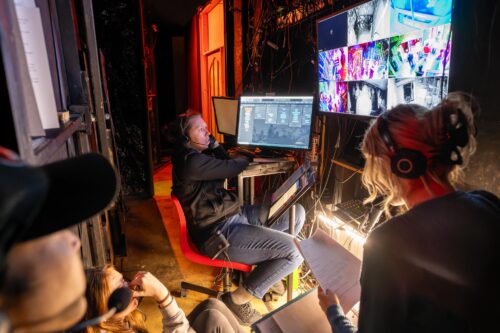
Illinois Theatre’s I Wish escape room, behind the scenes. Photo by Darrell Hoemann.
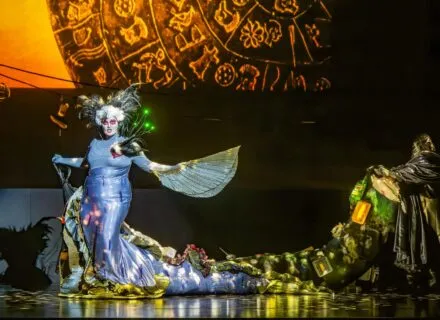
Lyric Theatre’s Black Square (2024) in the Tryon Festival Theatre at Krannert Center for Performing Arts. Photo by Darrell Hoemann.
more text
In a recent Lyric Theatre production, Alguire worked closely with both a costume designer and lighting designer to figure out how to embed lighting features into costumes to create eerie and stunning special effects. The process required collective brainstorming, exploration of available technologies, and plenty of trial and error. The AET program is bringing this kind of problem-solving acumen into classroom and studio training by centering a hands-on, experimental approach.
“We’re building students who have flexibility and adaptability, which is hugely valuable. Companies need specialized skills from their people, but they also need people who can think creatively and give them an edge on how to solve unique challenges.”
Students are also gaining valuable experience in interactive design outside of the proscenium. Amber Dewey Schultz, professor of theatre and game studies and design, and the assistant director of academic programs for the Siebel Center for Design, introduces students to design-thinking for theatrical and playable experiences both within and outside traditional theatre spaces. Schultz teaches popular courses around escape rooms and tabletop role-playing games where students learn how to develop narrative and environmental design.
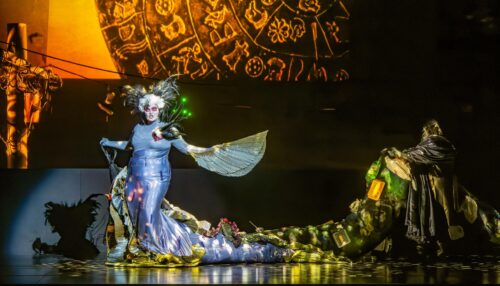
Lyric Theatre’s Black Square (2024) in the Tryon Festival Theatre at Krannert Center for Performing Arts. Photo by Darrell Hoemann.
“We are exposing our students to real challenges of the entertainment industry. There are opportunities in theatre and beyond to incorporate agency in storytelling. It isn’t new, but we are exploring it with fresh eyes and with increasingly accessible and advanced technologies.”
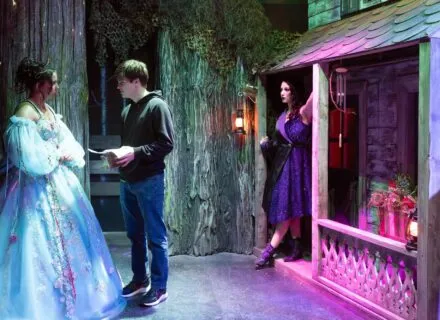
An actor interacts with an escape room participant in Illinois Theatre’s I Wish escape room. Photo by Darrell Hoemann.
conclusion
With Schultz as concept developer and director, Illinois Theatre produced The Heist: A Theatrical Escape Room in 2021 – an interactive experience where the audience became live-action role players in an escape room scenario with embedded COVID-19 safety protocols at the Krannert Center for the Performing Arts. The team collaborated with the Champaign-Urbana Community Fab Lab to build the physical puzzles and materials needed for the game. In spring 2024, Schultz teamed up with local company CU Adventures in Space and Time to produce another Illinois Theatre escape room called I Wish which was an interactive adaptation inspired by the Stephen Sondheim musical Into the Woods.
“There is so much play testing involved in the development process,” said Schultz. “So the actors and designers involved learn how the choices players make could fail the narrative design. So, we iterate and come back. There’s not just one way to do things, and students are learning that through this process.”
That ability to iterate and problem solve creatively and collaboratively – thinking beyond any rigid understandings of theatrical design and experience – is precisely what Alguire hopes each student walks away with when they complete their degree.
“We are excited to be exploring these areas and giving students the experiences, methodologies, and tools to be able to do this work in the professional world whether they are specifically going into the theatre industry or other fields,” said Alguire.
Schultz agreed, adding that in recent years the theatre department has recommitted to new works including more experimental productions. “This area is just going to grow. So we are going to need more people who can get into those interesting spaces at the intersections of design, research, and implementation. These students – the next generation – will determine where it all goes.”
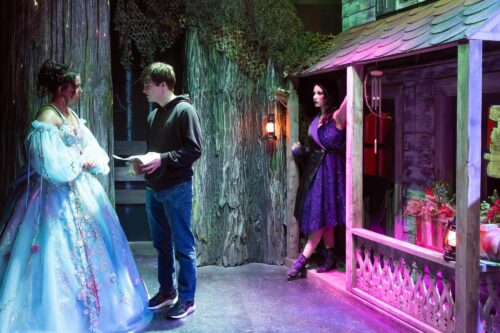
An actor interacts with an escape room participant in Illinois Theatre’s I Wish escape room. Photo by Darrell Hoemann.